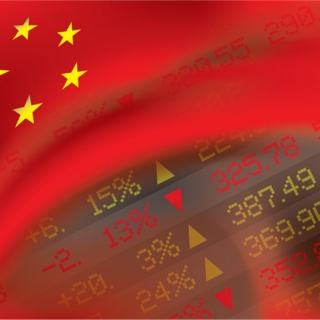


China's reaction to new U.S. tariffs will likely focus on domestic stimulus and strengthening ties with trading partners, according to analysts based in Greater China.
Hours after U.S. President Donald Trump announced additional 34% tariffs on China, the Chinese Ministry of Commerce called on the U.S. to cancel the tariffs, and vowed unspecified countermeasures. The sweeping U.S. policy also slapped new duties on the European Union and major Asian countries.
Chinese exports to the U.S. this year had already been hit by 20% in additional tariffs, raising the total rate on shipments from China to 54%, among the highest levied by the Trump administration. The effective rate for individual product lines can vary.
But, as has been the case, the closing line of the Chinese statement was a call to negotiate.
"I think the focus of China's response in the near term won't be retaliatory tariffs or such measures," said Bruce Pang, adjunct associate professor at CUHK Business School. That's according to a CNBC translation of the Chinese-language statement.
Instead, Pang expects China to focus on improving its own economy by diversifying export destinations and products, as well as doubling down on its priority of boosting domestic consumption.
China, the world's second-largest economy, has since September stepped up stimulus efforts by expanding the fiscal deficit, increasing a consumption trade-in subsidy program and calling for a halt in the real estate slump. Notably, Chinese President Xi Jinping held a rare meeting with tech entrepreneurs including Alibaba
founder Jack Ma in February, in a show of support for the private sector.
The policy reversal — from regulatory tightening in recent years — reflects how Beijing has been "anticipating the coming slowdown or even crash in exports," Macquarie's Chief China Economist Larry Hu said in a report, ahead of Trump's latest tariff announcement. He pointed out that the pandemic-induced export boom of 2021 enabled Beijing to "launch a massive regulatory campaign."
"My view stays the same," Hu said in an email Thursday. "Beijing will use domestic stimulus to offset the impact of tariffs, so that they could still achieve the growth target of ‘around 5%.'"
Instead of retaliatory tariffs, Hu also expects Beijing will focus on still using blacklists, export controls on critical minerals and probes into foreign companies in China. Hu also anticipates China will keep the yuan strong against the U.S. dollar and resist calls from retailers to cut prices — as a way to push inflationary pressure onto the U.S.
China's top leaders in early March announced they would pursue a target of around 5% growth in gross domestic product this year, a task they emphasized would require "very arduous work" to achieve. The finance ministry also hinted it could increase fiscal support if needed.
About 20% of China's economy relies on exports, according to Goldman Sachs. They previously estimated that new U.S. tariffs of around 60% on China would lower real GDP by around 2 percentage points. The firm still maintains a full-year forecast of 4.5% GDP growth.(Newsmaker.id)
Source: CNBC
Federal Reserve Chair Jerome Powell on Thursday responded to a Trump administration official's demands for information about cost overruns for a renovation project at the central bank's Washington hea...
The United States Commerce Department is set to impose preliminary anti-dumping duties of 93.5% on graphite imported from China after concluding the materials, which are a key component for batteries,...
U.S. President Donald Trump's decision to ramp up arms shipments to Ukraine is a signal to Kyiv to abandon peace efforts, Russia said on Thursday, vowing it would not accept the "blackmail" of Washing...
Federal Reserve Governor Adriana Kugler said the US central bank should keep interest rates steady "for some time," citing accelerating inflation as tariffs begin to push up prices. "Given the stabil...
Unemployment claims fell 7,000 to 221,000 in the week ending July 12, compared with the median estimate of 233,000, according to Labor Department data. The estimated range was 220,000-240,000 accordi...
Gold steadied and was set for a moderate weekly loss as investors assessed the outlook for Federal Reserve rate cuts after resilient US jobs and retail data eased concerns about the economy. Bullion traded below $3,340 an ounce, heading for a 0.5%...
The USD/CHF pair tumbles to around 0.8030 during the early European session on Friday. Persistent trade tensions and Federal Reserve (Fed) policy uncertainty boost the safe-haven demand, supporting the Swiss Franc (CHF). The preliminary reading of...
Oil headed for a back-to-back daily gain after US data showed the world's largest economy holding up despite the fallout from the Washington-led trade war, while market metrics pointed to near-term tightness. Global benchmark Brent rose toward $70...
 U.S. consumer prices increased by the most in five months in June amid higher costs for some goods, suggesting tariffs were starting to have an...
U.S. consumer prices increased by the most in five months in June amid higher costs for some goods, suggesting tariffs were starting to have an...
 European stocks erased early gains and closed mostly lower on Tuesday as markets continued to assess how potential tariffs from the US may hurt...
European stocks erased early gains and closed mostly lower on Tuesday as markets continued to assess how potential tariffs from the US may hurt...
 The U.S. central bank will probably need to leave interest rates where they are for a while longer to ensure inflation stays low in the face of...
The U.S. central bank will probably need to leave interest rates where they are for a while longer to ensure inflation stays low in the face of...
 President Donald Trump's renewed calls for Federal Reserve Chair Jerome Powell's resignation have prompted investors to protect portfolios against...
President Donald Trump's renewed calls for Federal Reserve Chair Jerome Powell's resignation have prompted investors to protect portfolios against...